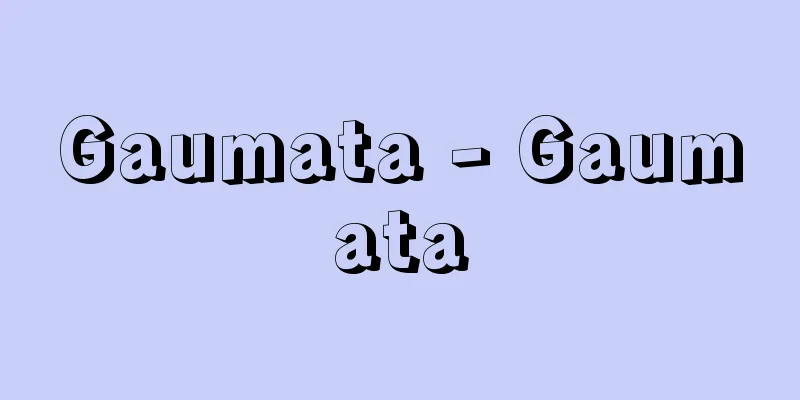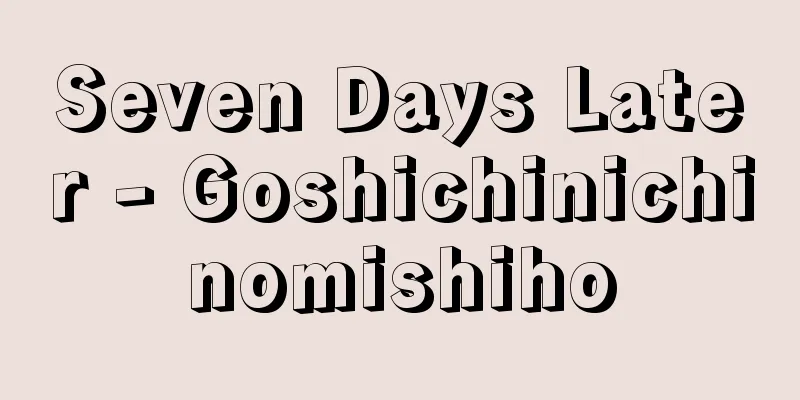Nine Stars

|
This is a superstition that was introduced to Japan's Onmyodo (Onmyodo) from ancient China and spread among the general public by practitioners of horoscopes. It is mainly practiced among fortune tellers and is recorded in the Takoshima calendar and other documents. The nine stars of Ippaku (First White), Jikoku (Second Black), Sanpeki (Three Green), Shiroku (Four Green), Goou (Five Yellow), Roppaku (Six White), Shichiseki (Seven Red), Happaku (Eight White), and Kyuushi (Nine Purple) are assigned to the five elements of Wood, Fire, Earth, Metal, and Water, and are then distributed to the Ten Heavenly Stems and Twelve Earthly Branches to create a Nine Star Chart that links them to the Eight Trigrams. These are then used to predict people's fortunes and the good and bad luck of directions, etc., by allocating directions to the Eight Trigrams to determine the main shrine. For example, Ichi-haku is Mercury, whose main palace is in the north, Nikoku is Saturn, whose main palace is in the southwest, and San-heki is Jupiter, whose main palace is in the east, but the Nine Stars go retrograde every year, and the central star moves and changes. When a person's star is in the central position, it is called the main star, and the year will be a year of eight-way target killing (blockage in all directions), and if the star is in the south, the north will be a target killing and should be avoided. When a star is in the central Chugoku, other adjacent stars will take their place and occupy the main palace, which is called the Anken-satsu direction, and is considered to be a great misfortune. [Shoji Inoguchi] Source: Shogakukan Encyclopedia Nipponica About Encyclopedia Nipponica Information | Legend |
|
古く中国から日本の陰陽道(おんみょうどう)に伝わり、方術の徒によって民間に広められた俗信。主として売卜者(ばいぼくしゃ)の間に行われ、高島暦などに記載されている。一白(いっぱく)、二黒(じこく)、三碧(さんぺき)、四緑(しろく)、五黄(ごおう)、六白(ろっぱく)、七赤(しちせき)、八白(はっぱく)、九紫(きゅうし)の九星を、木、火、土、金(ごん)、水の五行(ごぎょう)にあて、十干十二支(じっかんじゅうにし)に配して八卦(はっけ)に結び付けた九星図をつくり、方位や人の生まれ年にあてて、人間の運勢や方位の吉凶などを占う。また方位を八卦に配当して本宮を決める。たとえば一白は水星で北方を本宮、二黒は土星で西南を本宮、三碧は木星で東方を本宮などとするが、九星は毎年逆行して中央の星が移動交替する。ある人の星が中央の座にあたるとき、これを本命星といい、その年は八方的殺(てきさつ)(八方ふさがり)となり、星が南にあると北方を的殺として慎むべきだとする。ある星が中央の中宮にあるとき、他の隣接した星がかわって本宮を占めるものを暗剣殺方といい、大凶とするなどがある。 [井之口章次] 出典 小学館 日本大百科全書(ニッポニカ)日本大百科全書(ニッポニカ)について 情報 | 凡例 |
>>: Series - kyuusu (English notation) series
Recommend
Aoyama Gakuin
A private Christian school with its headquarters i...
League of Corinth - League of Corinth
Also known as the Hellatic League. In 337 BCE, aft...
Wilby, J.
…These Italian madrigals were introduced to Engla...
Duboisia myoporoides (English spelling)
…[Nitta Aya]. . . *Some of the terminology that m...
Senninbari - Thousand Needles
A white cotton cloth knotted with a single stitch...
Assabu [town] - Assabu
A town in Hiyama County, Hokkaido. It is located t...
Acetylcholinesterase
EC 3.1.1.7. Enzymes that cleave the ester bond of...
Family name - surname
〘Name〙 Family name and clan name . Myoji. Family n...
Owen, J.
…After the Restoration, the Puritans quickly disi...
bell tower
… [Hibino Takeo] [Western] A bell tower stands be...
Tokyo Girls' School
Japan's first national girls' school was o...
Nostoc algae (Nostoc algae)
A genus of filamentous cyanobacteria, it has heter...
West Indian bay tree
...The fragrance made by soaking allspice leaves ...
"Flower tradition book since Kao" - Kao Irai no Kadensho
...The Tanigawa school is mentioned in the "...
Galchieri, LF - Galchieri
...However, inflation and other economic problems...









